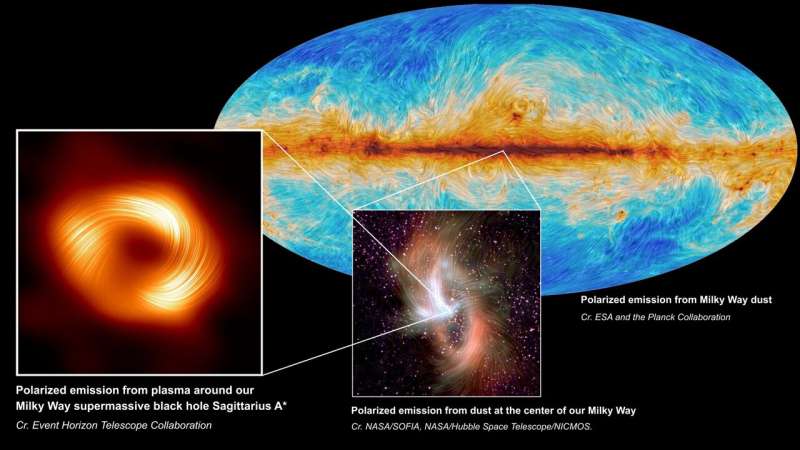March 30, 2024 report
This article has been reviewed according to Science X's editorial process and policies. Editors have highlighted the following attributes while ensuring the content's credibility:
fact-checked
trusted source
proofread
Saturday Citations: 100-year-old milk, hot qubits and another banger from the Event Horizon Telescope project

Is the milk sold today similar to the milk available 100 years ago? Here, drink this and give me your results. Also, physicists achieve superconductivity at a temperature slightly higher than 0 degrees Kelvin and slightly lower than 2 degrees Kelvin. The Event Horizon Telescope project released a glamorous new portrait of Sagittarius A*, while a separate group of physicists reported on a pair of black hole pals.
Qubits sweltering
Superconductivity, like Red Bull Pear Cinnamon Winter Edition, is only possible when the temperature drops to a significant degree. That's 0 degrees Kelvin, or -273 degrees Celsius. So unlike your computer, which is probably cooled by a fan, quantum computers have to be chilled with an elaborate cooling apparatus so that whatever particles you're using for qubits can be coherent.
Australian researchers now report that a particular kind of qubit based on the spin of individual electrons can maintain quantum coherence at a balmy 1 degree Kelvin, a temperature that would cook a Bose-Einstein condensate like a bowl of oatmeal in a microwave.
Disk perforated
A multi-institutional collaboration has potentially identified a mysterious, periodic burst of light in a distant galaxy as a small black hole orbiting a larger black hole, punching right through its accretion disk every 8.5 days. After the automated detection of the outburst by the All Sky Automated Survey for Supernovae, the researchers were baffled.
Fortuitously, Dheeraj "DJ" Pasham, a research scientist in MIT's Kavli Institute for Astrophysics and Space Research, read a recent paper by theoretical physicists in the Czech Republic positing that a galaxy's central black hole could be capable of hosting a second, smaller black hole at an angle from its accretion disk. The theory suggested that in this case, the smaller black hole would punch through the accretion disk at regular intervals, releasing a cloud of gas that would be taken up by the larger partner's magnetic field and emitted as polar jets in a periodic pattern.
The two teams collaborated on simulations incorporating NICER observations of the outburst to confirm the theory. They hypothesize that in December 2020, when the outburst was observed, a third object, likely a star, approached the system too closely and was shredded in a tidal disruption event into an accretion disk; when the smaller black hole punched through, it ejected a larger-than-normal plume. The researchers believe that there are "huge populations" of these kinds of systems in the universe.
Milk old
The heated debate among milk enthusiasts is whether the milk sold today is similar to the milk available 100 years ago. Physicists haven't yet determined how to propel a time-traveling cow to 88 miles per hour, but Skelte G. Anema, a researcher from New Zealand, recently studied a container of Defiance brand powdered milk frozen at the Shackleton base camp in Antarctica since 1907.
By subjecting it to a battery of dairy-based tests and studying the component composition of the powdered milk, they arrived at the surprising conclusion that milk is milk. Dr. Anema says, "Despite more than a century between the samples, the composition of bulk components and detailed protein, fat, and minor components have not changed drastically in the intervening years."
Photo flattering
The Event Horizon Telescope collaboration released new polarized light images this week of Sagittarius A*, the supermassive black hole at the center of the Milky Way, showing the orientation of the object's magnetic field polarization. The researchers note that the images are strikingly similar to polarized light imagery of the black hole in M87*, the first black hole ever imaged. This indicates that powerful magnetic fields are likely a regular feature of these massive objects.
Light oscillates, and it sometimes oscillates in a particular orientation; this is polarized light. By analyzing the polarization of light in the accretion disk surrounding a black hole, astronomers can map the magnetic field lines and generate highly detailed images of the disk.
"By imaging polarized light from hot glowing gas near black holes, we are directly inferring the structure and strength of the magnetic fields that thread the flow of gas and matter that the black hole feeds on and ejects," says Harvard Black Hole Initiative Fellow and project co-lead Angelo Ricarte.
© 2024 Science X Network





















